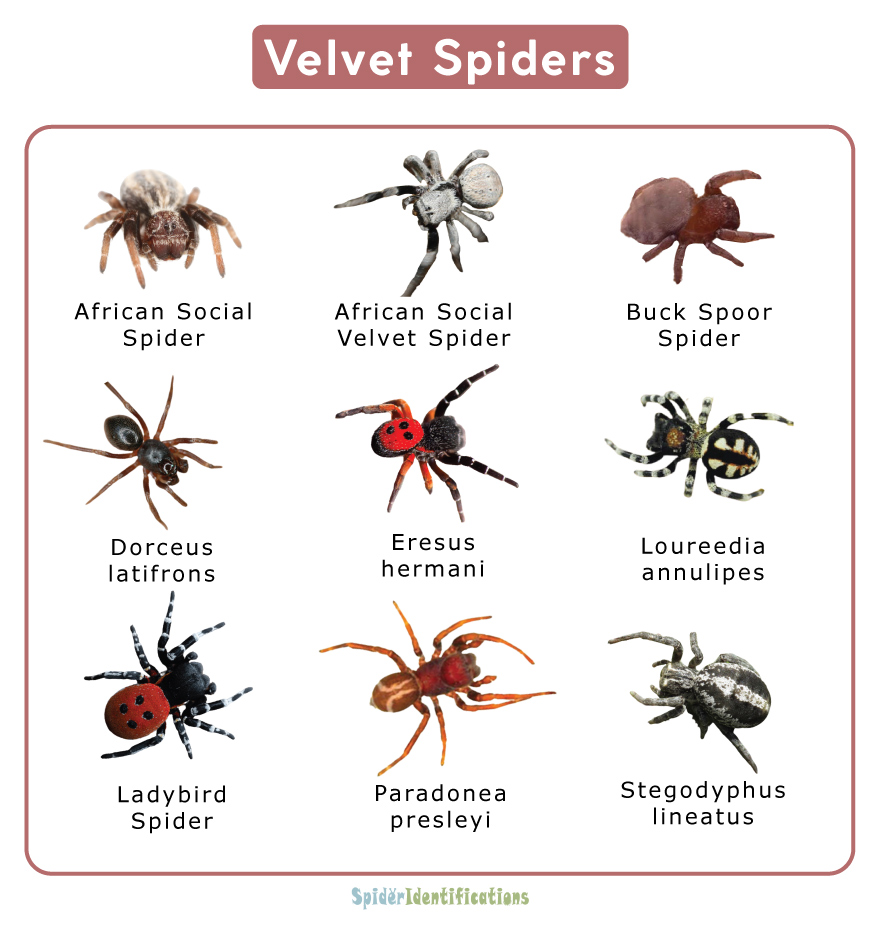Velvet Spiders
The velvet spider is a family known as Eresidae. The family is divided into 9 genera including around 130 species. The female spiders are known to sacrifice their lives for the care of their offspring.

Spiders Belonging to this Family
Adonea
- algarvensis
- algerica
- fimbriata
Dorceus
- Dorceus albolunulatus
- Dorceus fastuosus
- Dorceus latifrons
- Dorceus quadrispilotus
- Dorceus trianguliceps
Dresserus
- Dresserus aethiopicus
- Dresserus angusticeps
- Dresserus armatus
- Dresserus bilineatus
- Dresserus collinus
- Dresserus colsoni
- Dresserus darlingi
- Dresserus elongatus
- Dresserus fontensis
- Dresserus fuscus
- Dresserus kannemeyeri
- Dresserus laticeps
- Dresserus murinus
- Dresserus namaquensis
- Dresserus nasivulvus
- Dresserus nigellus
- Dresserus obscurus
- Dresserus olivaceus
- Dresserus rostratus
- Dresserus schreineri
- Dresserus schultzei
- Dresserus sericatus
- Dresserus subarmatus
- Dresserus tripartitus
- Eresus albopictus
- Eresus bifasciatus
- Eresus balcanicus
- Eresus crassitibialis
- Eresus granosus
- Eresus hermani
- Eresus lavrosiae
- Eresus moravicus
- Eresus pharaonis
- Eresus robustus
- Eresus rotundiceps
- Eresus ruficapillus
- Eresus sandaliatus
- Eresus sedilloti
- Eresus solitarius
- Eresus kollari Subspecies: Eresus k. frontalis, Eresus k. ignicomis,
- Eresus k. latefasciatus, Eresus k. tricolor
- Eresus walckenaeri Subspecies: Eresus w. moerens
Gandanameno
- Gandanameno echinata
- Gandanameno fumosa
- Gandanameno inornata
- Gandanameno purcelli
- Gandanameno spenceri
Loureedia
Paradonea
- Paradonea parva
- Paradonea presleyi
- Paradonea splendens
- Paradonea striatipes
- Paradonea variegata
Seothyra
- Seothyra barnardi
- Seothyra dorstlandica
- Buck spoor spider
- Seothyra griffinae
- Seothyra neseri
- Seothyra perelegans
- Seothyra roshensis
- Seothyra annettae
- Seothyra longipedata
- Seothyra schreineri
- Seothyra semicoccinea
- Seothyra henscheli
- Seothyra louwi
Stegodyphus
- Stegodyphus africanus
- Stegodyphus bicolor
- Stegodyphus dufouri
- Stegodyphus dumicola
- Stegodyphus hildebrandti
- Stegodyphus hisarensis
- Stegodyphus lineatus
- Stegodyphus lineifrons
- Stegodyphus manaus
- Stegodyphus manicatus
- African social velvet spider
- Stegodyphus mirandus
- Stegodyphus nathistmus
- Stegodyphus pacificus
- Stegodyphus sabulosus
- Indian cooperative spider
- Stegodyphus simplicifrons
- Stegodyphus tentoriicola
- Stegodyphus tibialis
- Stegodyphus tingelin
Physical Description and Identification
Adults
Size: The average size of female velvet spiders range from 0.47-0.59 in (12-15 mm), although the figure might vary, depending on each species.
Color: Bright colors like black, brown or sometimes gray are observed on almost all species. Ladybird spiders have an orange-colored body with black spots.
Other Characteristic Features: The hair is so glossy and thick that it looks like velvet, and hence the name velvet is given. Also, female spiders of this family exhibit genital plate, forming subgroup entelegyne spiders.
Eggs
Female velvet spiders lay eggs in a sac.
Spiderlings
Spiderlings take some time for incubation, and when they come out, their mother’s tissues had already been broken down. The young spiders follow matriphagy by consuming the corpse of their mother.
The Web
The velvet spiders make webs, cluttered with the debris of herbal stuff and sand. The web is similar to a silken tube made of wooly silk, sizing around 3.9 in (10 cm), tucked inside burrows or crevices.
Are Velvet Spiders Venomous
The velvet spider is not likely to be venomous for human. However, there is a possibility that it has some venom, potent for killing insects.
Quick Facts
| Lifespan | Around 5 years |
| Distribution | Eurasia and Africa |
| Habitat | Burrows, underground of deserts and rainforests, neo tropical areas, Afrotropical realm |
| Web Type | Orb Web |
| Diet | Insects |
Did You Know
- The spiders are “cribellate”, meaning they have certain spinnerets known as “cribellum”, for making the web.